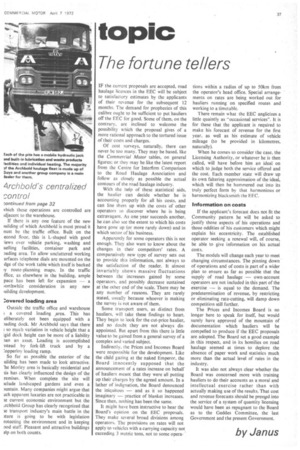topic
Page 35

If you've noticed an error in this article please click here to report it so we can fix it.
The fortune tellers
IF the current proposals are accepted, road haulage licences in the EEC will be subject to satisfactory estimates by the applicants of their revenue for the subsequent 12 months. The demand for prophecies of this calibre ought to be sufficient to put hauliers off the EEC for good. Some of them, on the contrary, are inclined to welcome the possibility which the proposal gives of a more rational approach to the tortured issue of their costs and charges_ Of cost surveys, naturally, there can never be too many. They may be based, like the Commercial Motor tables, on general figures: or they may be like the latest report from the Centre for Interfirm Comparison to the Road Haulage Association and follow as closely as possible the actual contours of the road haulage industry.
With the help of these statistical aids, the haulier can decide whether he is accounting properly for all his costs, and can line them up with the costs of other operators to discover where he is being extravagant. As one year succeeds another, he can also see the extent to which his costs have gone up (or more rarely down) and in which sector of his business.
Apparently for some operators this is not enough. They also want to know about the changes in their competitors' rates. A comparatively new type of survey sets out to provide this information, not always to the satisfaction of the reader. It almost invariably shows massive fluctuations between the increases gained by some operators, and possibly decrease sustained at other end of the scale. There may be any number of reasons. They are rarely stated, usually because whoever is making the survey is not aware of them.
Some transport users, as distinct from hauliers, will take these findings to heart. They begin to look for the cut-price haulier, and no doubt they are not always disappointed. But apart from this there is little value to be gained from a general survey of a complex and varied subject.
Indirectly, the Prices and Incomes Board were responsible for the development. Like the child gazing at the naked Emperor, the Board innocently supposed that the announcement of a rates increase on behalf of hauliers meant that they were all putting up their charges by the agreed amount. In a lather of indignation, the Board denounced the iniquitous — and as it so happened imaginary — practice of blanket increases. Since then, nothing has been the same.
It might have been instructive to hear the Board's opinion on the EEC proposals. They make several broad divisions among operators. The provisions on rates will not apply to vehicles with a carrying capacity not exceeding 3 metric tons, not to some opera
tions within a radius of up to 50km from the operator's head office. Special arrangements on rates are being worked out for hauliers running on specified routes and working to a timetable.
There remain what the EEC anglicizes a little quaintly as "occasional services". It is for these that the applicant is required to make his forecast of revenue for the first year, as well as his estimate of vehicle mileage (to be provided in kilometres, naturally).
When he comes to consider the case, the Licensing Authority, or whatever he is then called, will have before him an ideal on which to judge both the service offered and the cost. Each member state will draw up its own faltering approximation of the ideal, which will then be hammered out into its truly perfect form by that harmonious or harmonizing blacksmith the EEC.
Information on costs .
If the applicant's forecast does not fit the Community pattern he will be asked to justify those aspects of his operations and those oddities of his customers which might explain his eccentricity. The established operator seeking a renewal will, of course, be able to give information on his actual costs.
The models will change each year to meet changing circumstances. The pinning down of operations and of costs is part of a wider plan to ensure as far as possible that the supply of road haulage — own-account operators are not included in this part of the exercise — is equal to the demand. The predetermination of revenue, by restricting or eliminating rate-cutting, will damp down competition still further.
The Prices and Incomes Board is no longer here to speak for itself, but would surely have approved of the mountain of documentation which hauliers will be corn pelted to produce if the EEC proposals are adopted. The Board set a good example .in this respect, and in its homilies on road haulage seemed at times to deplore the absence of paper work and statistics much more than the actual level of rates in the industry.
It was also not always clear whether the Board was concerned more with training hauliers to do their accounts as a moral and intellectual exercise rather than with actually making use of the results. That cost and revenue forecasts should be prened into the service of a system of quantity licensing would have been as repugnant to the Board as to the Geddes Committee, the last Government and the present Government.




















































































